Celastrina dipora, the dusky blue cupid, is a small butterfly found in India that belongs to the lycaenids or blues family.
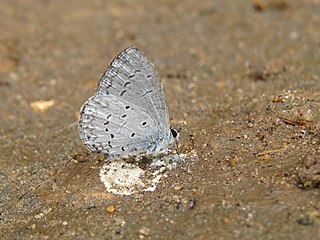
Celastrina lavendularis, the plain hedge blue, is a small butterfly found in Sri Lanka, India, and across the Indomalayan realm that belongs to the lycaenids or blues family.
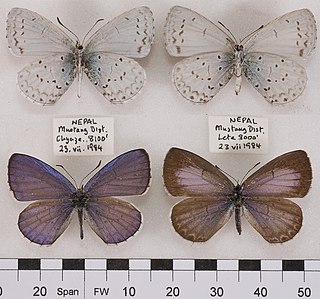
Celastrina huegeli, the large hedge blue, is a small butterfly found in India that belongs to the lycaenids or blues family.
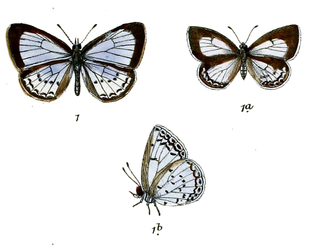
Celastrina iynteana, the Jyntea hedge blue, is a small butterfly found in India that belongs to the lycaenids or blues family.

Celastrina is a genus of butterflies in the family Lycaenidae found in the Palearctic, Nearctic, Indomalayan and Australasian realms.

The Appalachian azure is a butterfly in the gossamer wings family Lycaenidae. The male is light blue on the upperwing with a narrow, dark line running along the edge of the forewing. The underwing is chalky white and is dotted with small, pale dark spots. The very back of the hindwing has a row of dark spots running along the edge and contained by a faint zigzagging band. Females are similar to the males but have broad dark wing borders instead of the male's narrow ones. The adult butterfly has a 1.1–1.4-inch (2.8–3.6 cm) wingspan. It is the largest azure in the area.

Celastrina ladon, the spring azure or echo blue, is a butterfly of the family Lycaenidae. It is found in North America from Alaska and Canada south of the tundra, through most of the United States except the Texas coast, southern plain and peninsula Florida; south in the mountains to Colombia, also on Molokai island, Hawaii.

Celastrina neglecta, the summer azure, is a butterfly of the family Lycaenidae. It is found in North America. Layberry, Hall, and Lafontaine, in The Butterflies of Canada, describe the species:
The upper surface is pale blue with an extensive dusting of white scales, especially on the hindwing. In some females the blue is almost entirely replaced by white with a small amount of blue near the wing bases. Females have a broad blackish-grey band on the outer third and costa of the forewing. The underside is chalky white to pale grey with tiny dark grey spots and a zigzagged submarginal line on the hindwing.
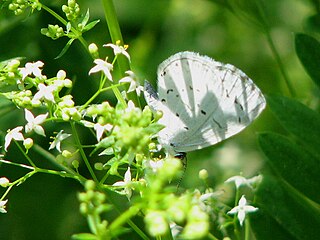
Celastrina serotina, the cherry gall azure, is a butterfly of the family Lycaenidae. It is found across North America as far north as the treeline. Its flight time is between mid-May and mid-June in eastern Ontario after the spring azure and before the summer azure. The larva has been reported to feed on galls of eriophyid mites and apparently also on the mites themselves, making them one of the rare species of carnivorous Lepidoptera. It is commonly found around woodland roads of upland mixed deciduous hardwood forests which are surrounded by wetlands.
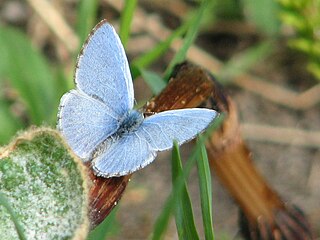
Celastrina lucia, the lucia azure, northern azure, eastern spring azure or northern spring azure, is a species of butterfly of the family Lycaenidae. It is found eastern North America, ranging from the Maritimes south through the Appalachian Mountains to West Virginia.

Celastrina gozora, the Mexican azure, is a butterfly of the family Lycaenidae. It is found in Mexico, Panama, and Honduras.

Celastrina idella, the American holly azure, is a species of butterfly of the family Lycaenidae. It is found on the east coast of the United States.
Celastrina humulus, the hops azure, is a species of blue in the family Lycaenidae. It is found in North America. The main host plant is wild hops. They can change their body temperature by behaviors like basking or sitting in shade.

Celastrina echo, known generally as the echo azure or western azure, is a species of blue in the butterfly family Lycaenidae.











